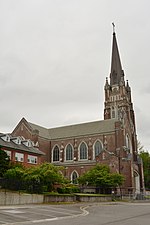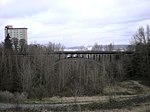Engine House No. 8 (Tacoma, Washington)

The Engine House No. 8 in Tacoma, Washington, which has also been known as Fire Station No. 8, was built in 1909. Located at 4301 S. L St., it was listed on the National Register of Historic Places in 1986.It was designed to be compatible with its residential neighborhood: "The fire station possesses a distinctly domestic scale that seeks to harmonize the building with its residential neighbors. Its blocky mass, together with its flared gable roof, wide eaves and knee braces imitate the form of Craftsman style "chalets" that were a very popular residential type in Tacoma at this time."This station was replaced in 2006 with a larger facility, and is now a private residence.
Excerpt from the Wikipedia article Engine House No. 8 (Tacoma, Washington) (License: CC BY-SA 3.0, Authors, Images).Engine House No. 8 (Tacoma, Washington)
South K Street, Tacoma
Geographical coordinates (GPS) Address Nearby Places Show on map
Geographical coordinates (GPS)
| Latitude | Longitude |
|---|---|
| N 47.218333333333 ° | E -122.44777777778 ° |
Address
South K Street 4301
98418 Tacoma
Washington, United States
Open on Google Maps







